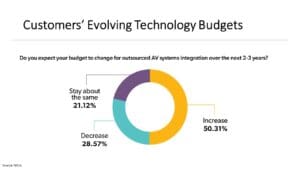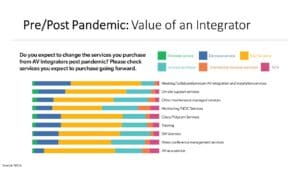The value of an integrator is evolving as the workplace continues to change and customers tailor unique solutions to their own needs, integrators should understand the unifying threads of technology end user customers need the most post pandemic.
Research by NSCA and Commercial Integrator’s sister brand MyTechDecisions, revealed customer demand trends about integrated solutions needed post pandemic.
“The stuff that your customers determined to be important and paid you to install pre-pandemic is different than the stuff that your customers are going to determine and prioritize for you to install post pandemic,” said Tom LeBlanc, executive director at NSCA at recent webinar.
Watch: Your Customers’ Post Pandemic Needs: Exclusive Research & Analysis
“As an integrator, you really have to evolve with your customers’ demands; are you well positioned to provide the solutions that your customers now deem important? The tricky part is knowing what those new customer priorities are, and it’s not easy to make a blanket statement,” he says.
Moving Desks from a Cube to Home
According to the survey, 40% of respondents worked from home one or more days per week prior to the pandemic and almost half are working from home after the pandemic.
If that number were to change to working from home 3-4 days per week, that poses a significant change, commented Daniel Abrams, CTS.
If employees are coming into the office only 1-2 days per week, integrators must talk to their customer about what their workflow is like. “There’s no one size fits all in the integration industry — there’s been so much customization in all kinds of different systems that a one size fits all is sort of on its last leg,” says Jonathan Blackwood, editor director of Commercial Integrator and MyTechDecisions.
 It starts with having a “conversation with your clients upfront; understand what they’re thinking for their business strategy, not just for their technology strategy, [integrators can then] be the conduit to tell them, OK these are the technologies that will work the best for you; these are the technologies that may not work for you,” says Blackwood.
It starts with having a “conversation with your clients upfront; understand what they’re thinking for their business strategy, not just for their technology strategy, [integrators can then] be the conduit to tell them, OK these are the technologies that will work the best for you; these are the technologies that may not work for you,” says Blackwood.
“The same system that you’ve put in three or four times, that you know is going to work, and is going to allow them to collaborate, might not fit into their hybrid work strategy,” says Blackwood.
Drivers to WFH
About 38% of respondents said the main drivers to working from home are the overall pandemic experience; employees with computer-based work and little interaction found they could work from home.
About 35% said the company culture encourages working from home. About 32% employees will not be working from home and about 30% said one of the drivers was that their company is AV-enabled – the installation of a cloud and/or AV infrastructure that facilities remote work. About 25% said employees work from home to save on real estate.
Huddle Rooms are the next Swiss Army Knife Post Pandemic
“ Before the pandemic, so much of the focus in the integration market was on huddle rooms and cranking out as many huddle rooms as humanly possible,” says LeBlanc.
Before the pandemic, so much of the focus in the integration market was on huddle rooms and cranking out as many huddle rooms as humanly possible,” says LeBlanc.
Those huddle rooms are now taking on new uses – they are still used as a collaboration space except maybe only one person is using the room. “The function may not change, but the utilization of the space that may have been for two, or three people before, may be limited to an individual now,” says Abrams.
“I think moving forward [huddle rooms are] going to be more of a Swiss army knife,” says LeBlanc. “The huddle room is really going to need to evolve into something that can fit multiple different needs of a small, enclosed space…the technology is going to be there for every possible use case of a huddle,” he says.
Enabling Collaborative Work to Happen
“The AV industry is not necessarily dictating the ways in which collaboration is happening as much as we used to. We used to enable collaboration through the tools that we provided, and people would utilize them in the spaces the way in which we intended for them to be used, or we hope that they were using them,” says Abrams. “Now, it has become the norm for almost everybody in the industry to utilize some level of collaborative or remote sharing technology.”
Abrams noted customers are guiding integrators more post pandemic “…saying this is how we work, this is what we need to accomplish, and get done; let’s figure out the best utilization of the tools, as opposed to the industry bringing them tools, and saying we have tools for you to help do all of these things.”
WFH Enablement
 About 40% of the survey respondents said they are shifting all meeting rooms to remote collaboration, such as with Zoom, Microsoft Teams, and Google Meet. Thirty-one percent are providing employees with equipment to enhance home office productivity.
About 40% of the survey respondents said they are shifting all meeting rooms to remote collaboration, such as with Zoom, Microsoft Teams, and Google Meet. Thirty-one percent are providing employees with equipment to enhance home office productivity.
Thirty-two percent are equipping more meeting/collaboration rooms with AV, with plans to provide even more, according to the survey.
Employees that are in the office want to get the most of out the experience, which may be a factor as to why 25% say they are converting office spaces to be more training and event oriented.
The survey also revealed tech decision makers are more willing to pay for service oriented work, such as support maintenance, network operations, monitoring solutions, and training and video conferencing solutions.
Half of survey respondents indicated their budget for outsourced AV systems over the next 2-3 years are expected to increase, whereas 30% said their budgets would decrease, and 20% are expected to stay the same.
“AV is not a luxury, but a necessity,” says Abrams. “AV is what is facilitating communication and collaboration amongst the people in their offices, at a time when that’s how more people are working than ever before.”
The Importance of AV-as-a-Service Post Pandemic
Integrators should start providing more comprehensive training package to customers to make sure there is a lot of comfort, so there can be the high levels of utilization, and success with using it, to allow their business to operate. Essential pieces of operations are largely treated like a service and can be budgeted for with a service plan, commented Abrams.
 IT managers who are overlooking technology implementations are used to service models — in two or three years, the system will need updates and if anything breaks the integrator is able to fix it. Having a service plan “puts the manager at ease because they’ve got all kinds of problems to deal with,” says Blackwood. “If integrators don’t start providing IT managers with the type of solutions and the type of payment solutions that they’re used to, you’re going to fall behind.”
IT managers who are overlooking technology implementations are used to service models — in two or three years, the system will need updates and if anything breaks the integrator is able to fix it. Having a service plan “puts the manager at ease because they’ve got all kinds of problems to deal with,” says Blackwood. “If integrators don’t start providing IT managers with the type of solutions and the type of payment solutions that they’re used to, you’re going to fall behind.”
AV-as-a-service, “is no longer optional,” says Abrams, “it’s a requirement for businesses” across the AV industry.
“The pandemic has taught us that fluidity is really important. What happens today is relevant to tomorrow only a little bit because we don’t know exactly where tomorrow is going to take us, so we have to have a plan based off yesterday and a plan based off tomorrow and a plan based off the tomorrow that we don’t know yet,” says Abrams.
Integrators must be nimble and be able to respond quickly. “IoT presents an opportunity in a lot of unique and interesting ways,” says Abrams. “It’s important that we don’t over complicate it while we do it, and that we focus on providing solutions to our customers’ challenges.”










